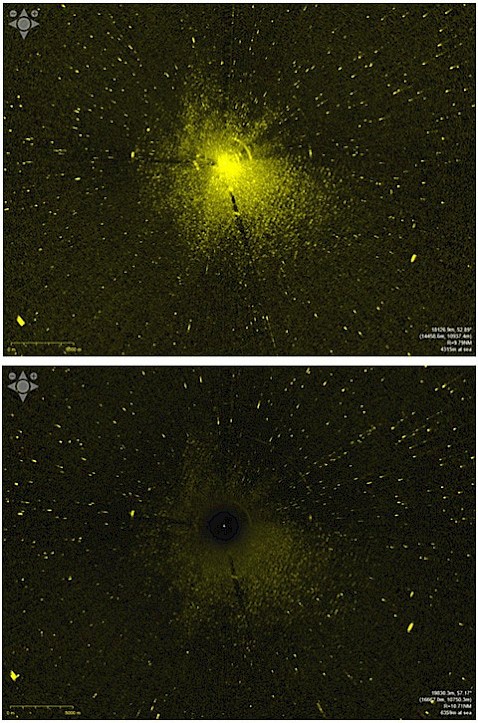Sensitivity Time Control (STC)
The power of a radar signal reaching a distant target diminishes with range according to the well-known radar range equation, so that the reflected power that finally returns to the radar receiver depends on 1/R4, where R is the target range. There is clearly a significant difference in the energy received for short ranges, versus energy received at the maximum range of the radar (defined as the range at which the received signal is equal to the minimum detectable signal). This disparity in returned signal strength for short and long range targets could easily cause the input receiver to saturate for short-range returns, or alternatively to have reduced sensitivity at longer ranges if gain is reduced to avoid short-range saturation. The way this is handled is to have a range-dependent function that attenuates short-range targets and progressively reduces the attenuation for longer ranges. This is called Sensitivity Time Control (STC).
When operating on the received analogue signal, the STC function is capable of adjusting the attenuation in a way that permits detection at longer ranges (where no signal attenuation is desired) and avoiding overload at short ranges (where higher return signals could saturate the receive-and-reduce discrimination). It is significant that this process happens in the front-end analogue processing stage. If it were to occur after digitisation, then there would need to be an extreme degree of resolution in the digitisation process to maintain sensitivity from the largest to the smallest return signal.
In some situations, a form of STC may be used to affect the appearance of the radar video on a display, including the suppression of near-range sea clutter. In this situation, the STC is performed after digitisation of the radar signal. The radar signal will have been digitised into, say, 256 amplitude levels (8 bits) with the minimum signal represented being 1/255 of the peak signal. The STC function can be implemented as a digital gain function that modifies the value of each radar sample by a gain, G, which is calculated as a function of range. For example, G = r/R, where r is the range of a sample and R is the maximum range.
In Cambridge Pixel's SPx Radar Processing library, an STC function is provided by a process that occurs after digitisation and converts samples to adjusted values according to a range-dependent gain. The gain is calculated from a piecewise linear curve, which allows for a constant gain at short ranges, before transitioning to a range-dependent value that approaches unity at longer ranges.
The parameters associated with this process allows the effect of STC to be adjusted. Since this STC is applied to the digitised radar signal, the process is primarily used as part of the display processing to reduce the brightness of the radar video close to the radar. As this process is simply adjusting the values of already-digitised data, there is no increase in information or improvements in radar performance, but there is a potentially useful improvement in the appearance of the displayed radar. An example of this is shown in Figure 1.

It should be noted that it is perfectly possible to have front-end STC active (for example as handled by the radar's signal processing), whereby the radar signal is attenuated at short-range to preserve sensitivity at longer ranges, AND have a display-related STC function to further modify the brightness of the radar video as a function of range.
In terms of a user control, STC is normally associated with "Sea Clutter" removal, as the principal effect is to remove the effect of near-range sea clutter from the display.
Fast Time Constant (FTC)
The FTC is a high-pass filter, which removes low frequency components from the video. In terms of a user control in maritime radars, this is most often associated with "Rain Removal", as the effect of rain can be to produce a low frequency distribution in the area of the rain. For other situations, FTC may be used to emphasise the leading edge of a detection, thereby reducing possible confusion caused by countermeasures...
Subscribe to continue reading this article, it's free.
Free access to Engineering Insights, authored by our industry leading experts.
You will also receive the Cambridge Pixel newsletter which includes the latest Engineering Insights releases.
Fill in the form below and you will be sent an Instant Access link.


